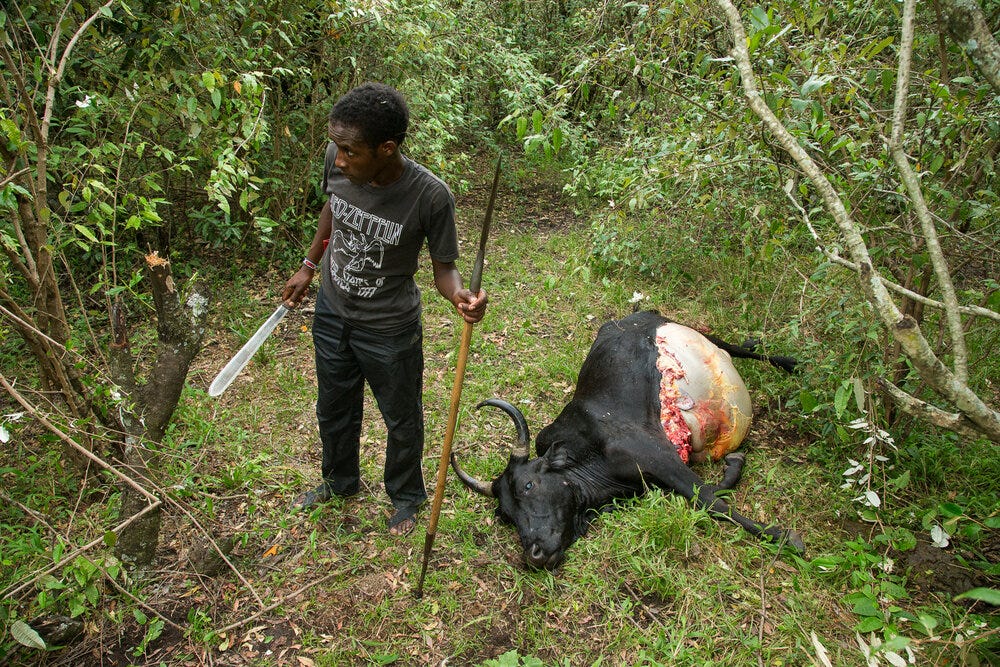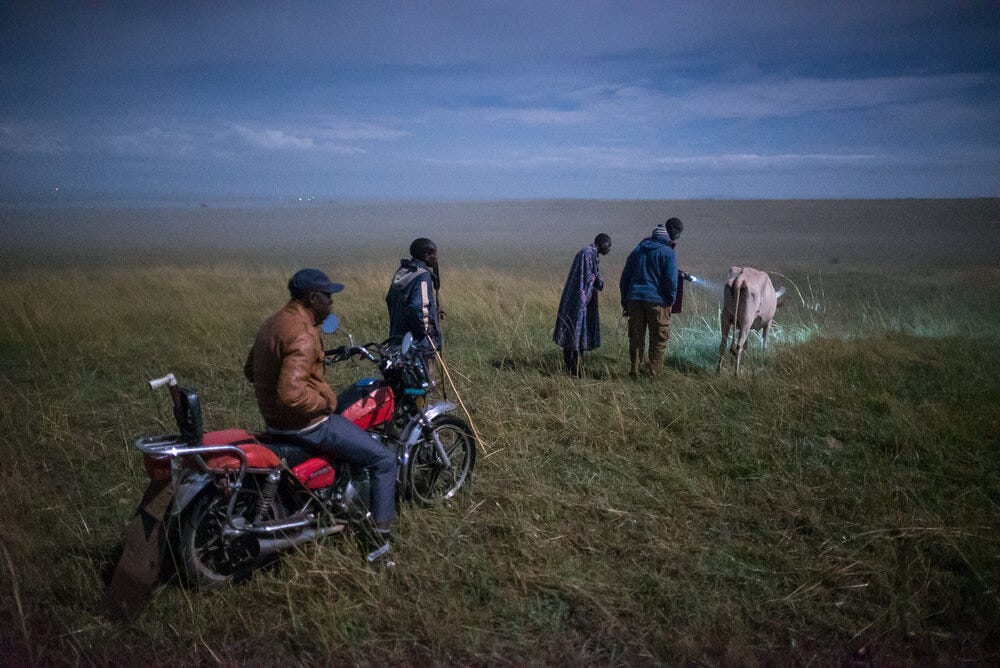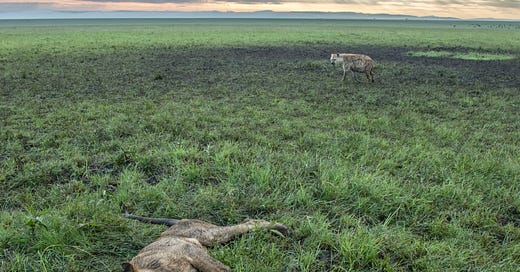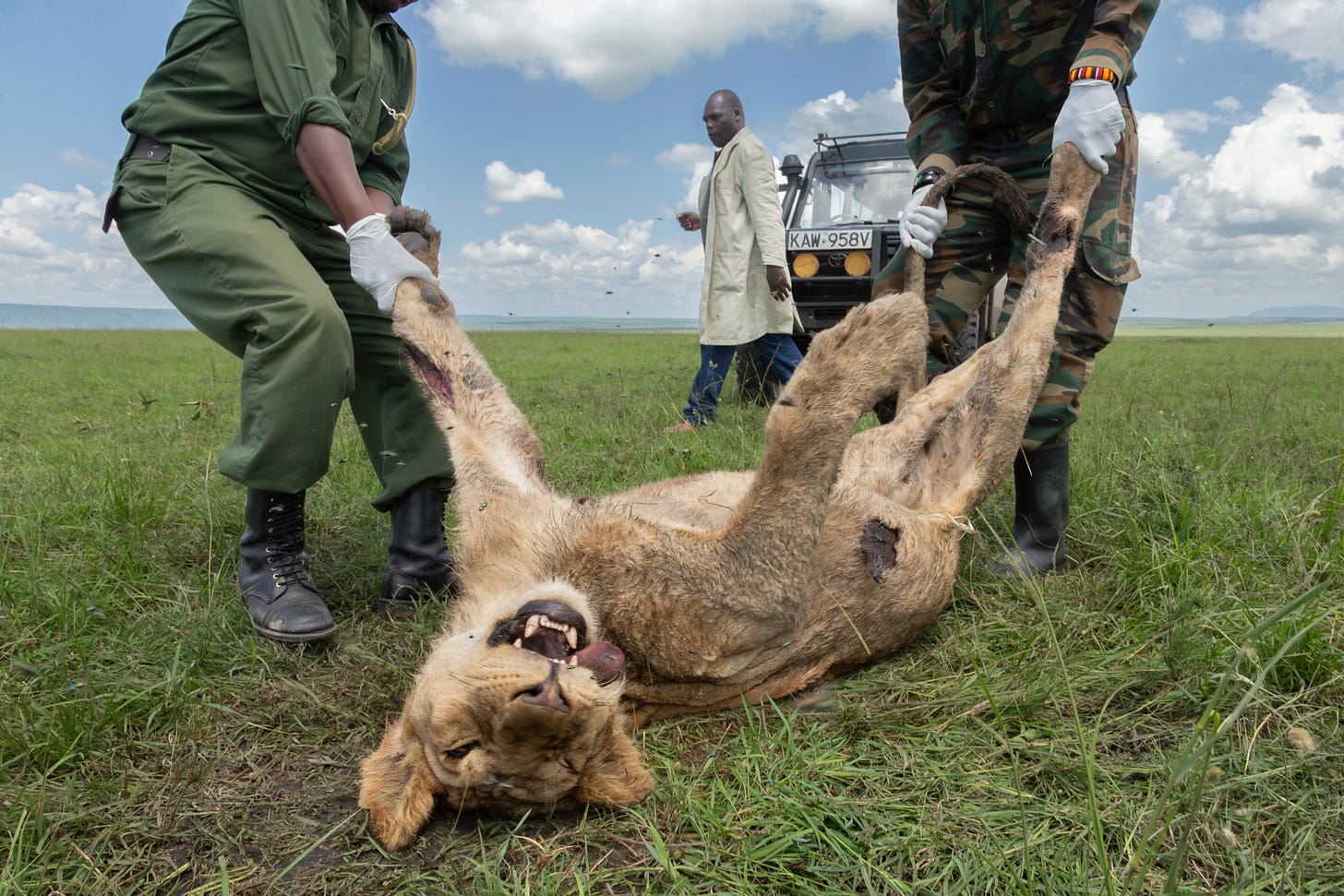For previous chapters click here
Poisoning Africa
I flew home to England after six frustrating weeks with Simon, stumbling from one scene of misery to the next. The pictures were OK but overwhelmingly horrible: dead sheep, goats and cows ripped apart by hyenas and lions, so many dead elephants I lost count, some rotten, some dried out husks of skin, others hacked up with axes. I was refused entry to the bar at the Serena Hotel in the Maasai Mara one night and told to take a shower because I turned up plastered in blood and tissue from shooting an elephant being de-tusked by rangers. I shot images of poison arrows being made and sold, and I shot images of elephants killed with them. I met old poachers who revealed the tricks of the elephants-killing trade, and I met farmers and crop sprayers whose lives – and those of their kids – were riddled with illness and death. And I spent long nights walking across the Maasai Mara with young Maasai morans (warriors), herding their cows illegally across the plains and running terrified in the dark when the lions attacked and the cows stampeded.
The whole ‘Poisoning Africa’ story was an absolute shit show of misery and I was deeply disheartened by it because ultimately it wasn’t a story. It was a loose collection of images, all shot around the edges with the middle part missing, like an eclipse at totality. What I needed was an actual poisoning event, preferably with lions. But I’d had enough. All the inaction depressed me, and I felt horribly guilty at wasting so much money and pissed off because I was failing. I’d spent the last two weeks of the shoot sitting around in a lodge in the Maasai Mara waiting for the phone to ring. It never did. So I quit a week early and went home to sulk.
Barely two hours had passed from me walking through my front door when the phone rang. It was my friend Mark McEwan – the young camera assistant I’d taken on his first job to the Isle of Skye on a drug-fuelled rampage – who was in the Maasai Mara shooting a landmark series for the BBC Natural History Unit called Dynasties. He and a few other friends were following the lives of the Marsh Pride, perhaps the most famous lion pride of all.

The Marsh Pride had featured in the BBC’s Big Cat Diary and innumerable subsequent sequences and documentaries. No other pride has ever been so closely filmed, photographed or monitored. They were the lions that ruled the highly prized Musiara Marsh, a small bog on the western edge of the Maasai Mara a stone’s throw from the Mara River. They ruled the plains to the east, beyond a ditch called Bila Shaka, and they roamed south to Paradise Plain and beyond. In the fat months of the summer they feasted on zebra and wildebeest when the great migration popped north into southern Kenya from the Serengeti in Tanzania. In the lean months they survived on whatever they could bring down – topi, kongoni, impala, waterbuck, warthog and, of course, cows. Back then they were far from their prime. The males were absent, leaving just an extended family of young cubs and teenagers, held together by the power of mothers, daughters and sister: four lionesses, including Big, who at seventeen was the oldest lion in the Mara. They were an extraordinary sisterhood – cunning, devoted and above all resourceful. And they’d just been poisoned.
I felt like such a fucking idiot. Bibi was already dead. Another unknown lion, eaten by hyenas, couldn’t be identified, and a mature female called Siena was missing. Siena’s sub-adult son Alan was still alive but not looking good. I remained silent on the phone while Mark broke it all down.
‘OK, I’ll see you in the morning,’ I finally said, phoned Simon and told him to meet me in the Mara then got straight in the car, drove back down the M4 and managed to get the night flight to Nairobi.
Alan was just about hanging on when we pulled up next to him the following morning in the Land Cruiser with Simon, who’d driven from home to meet me and my friend Anthony, a local Maasai guy who runs a small camp in the Mara. Although severely weakened by the poison and still very ill, Alan was apparently going to make it, having been jabbed several times with atropine, a drug that blocks the receptors in the brain that the poisons blow out. Just his back leg and the tip of his tail were visible, poking a few inches proud of the warthog hole he’d climbed into to escape the heat of the midday sun. After an hour or so he forced himself backwards out of the hole and staggered a few feet through the grass like a Sunday-morning drunk to lap lethargically at a small waterhole. He looked terrible. His eyes had sunk deep into his face and his head slowly swayed as he stared with empty intent into the plains beyond the cars that had gathered around him.

‘Buffalo and hyaena are his greatest threat now,’ Simon said. ‘If he’s caught out here, he’s a goner.’
A ranger car had been despatched to protect him and it was now parked a few feet away. Abandoned by the pride, which needed to feed themselves, with his mother Siena missing or dead, Alan was alone in the world. We stayed with him for a few hours before getting bored and deciding to scout for dead vultures. It wasn’t long before we found a tree with three corpses in. Simon scaled it in bare feet and threw the vultures to the ground, where we buried them. We soon came across others, but because it was starting to get dark we stashed them in the car. Alan was sleeping when we stopped by again, watched over by rangers who were there for the night, so we headed off to find a lodge.

We headed out just before dawn the following morning, bouncing along the dirt tracks around the edge of the marsh to where we’d left Alan the previous night. We passed a Maasai boma (homestead) in the grey morning light, near which we watched a pack of dogs that surrounded a wildebeest in a small stream. The wildebeest had a spear hanging out of its belly. Anthony explained that it had probably been speared to feed the dogs, or maybe it was just boys having fun. We watched for a moment as the dogs cornered the stricken creature in the water, then drove off listening to Simon ranting about the Maasai to Anthony, who was Maasai. It was a standard early-morning conversation.
One of the filming cars found Alan first. They messaged us his location and we sped across the plains to get there as fast as we could. He was apparently all alone and the ranger car was nowhere to be seen.
When we pulled up not far from him he looked dead. Nobody had seen him breathe that morning, and his body looked limp and lifeless, just muddy and flat in the damp grass. We watched him for a while to see if he was alive, but there was nothing. I stepped out of the car and headed over to see what had happened.
It was as if my entire being suddenly focused like the sun through a magnifying glass. My brain, my soul, my vision, were all concentrated down to a tiny dot – a single, dulled yellow eye, with a pupil so piercing that it froze me to the spot, not blinking nor straying, just fixed on me like a laser. The eight or so feet that separated us were no more than a languid pounce to the lion, so for me to run back to the car was not an option. He growled, a deep, guttural, horror-film growl that tore through my nervous system in a way so visceral, so primal it’s almost impossible to describe, other than to say it was just fucking terrifying. I hung there motionless, time evaporated, fear gripped me tight.
‘So you’re not dead, then?’ I muttered quietly to the angry-looking cat, then softly whispered.
Alan didn’t respond, so I held my gaze on his and slowly inched one of my feet backwards, then delicately rocked on it until I was sufficiently balanced to gently swing the other one back. Two more steps in reverse and the lion blinked, a few more and he looked away briefly, betraying his state of mind, giving me the confidence to run backwards and leap to safety in the Land Cruiser.
It took me a moment to compose myself, my heart firing on all cylinders. I felt stupid, of course, for ignoring everyone’s advice and walking up to the lion, but ultimately I was glad – Alan was still alive. He didn’t look good, though, his fur matted in the thick black cotton mud, his hind legs and flank bearing deep and penetrating wounds. He’d clearly been attacked.
The rangers, it later turned out, had fallen asleep. Alan had slunk away in the darkness and buffalo had found him. A bullseye of green grass, ringed by scoured mud behind him, revealed his fate. He’d been trampled. We could see them, a large herd, gently grazing on the plain, perhaps half a mile away in the grey dawn light.
A hyena appeared on the periphery and circled in with nonchalant intent. She stopped to sniff, then carried on drawing closer while pretending she wasn’t. She wagged her stumpy little tail, pretended to look in the wrong direction, kept her head low, avoided eye contact; all the things at which hyenas are so brilliant. A hypnotic mastery of disinterest, aimlessly ambling ever closer until the gap was too tight to close. We scrambled to start the car and drive in on her as she made her final quick circle in on the lion. As Anthony swung the car almost on top of Alan’s body I leant out as far as I could to hit the hyena as she went for the lion’s back leg. I missed her, and she jumped out of the way briefly before going in again. I shouted at her and punched at her another time as she sniffed Alan’s hind end but she ignored me. Alan lifted his head and growled at her, and she backed off a little. Then he rolled over on his back and struck his legs in the air in the most relaxed manner he could muster to show the hyena he wasn’t injured, he was just resting. The hyena slunk back a few paces and sat down to watch.
A brief argument between the cars broke out on the radios. There was Simon and me in one car with our friend Anthony, and a couple of other cars with the BBC crews and drivers. Some thought we should let the hyena kill Alan. We disagreed, Simon angrily so. To allow the hyena to kill the lion wasn’t letting nature take its course, it was possibly condemning the hyena to the same fate as the lion, and in any case a poisoning event isn’t nature.
As we discussed what to do, Alan’s breathing become increasingly laboured, which we knew was a bad sign. Eventually he forced himself to his feet and staggered the three or four feet to our car, where he collapsed and dragged himself under.
‘He’s got a punctured lung,’ Simon insisted. ‘You can hear it. We need to get the vet here or he’s going to die.’
The next two or three hours was a painful lesson in frustration as we got on our phones and tried everything we could do to get a vet on site. Most frustrating of all was that the vet that we did manage to get to come to the lion’s assistance was trying to reach us but the river at ‘Double Crossing’ was swollen from a night of torrential rain and he couldn’t ford it. So we tried to get a chopper to pick him up, but we couldn’t find one. Eventually, after waiting several hours, the river dropped enough and the vet’s car could cross. A brave guy, as it’s not a river you’d want to be swept away by – if the swirling current didn’t get you, then the crocs certainly would.
The vet’s car eventually pulled up tight to our side and we explained the situation. Dr Campaign Limo, wearing a white lab coat and looking serious, was the head vet in the reserve. He attempted to peer under our car but he couldn’t get a view of the lion, so it was agreed that we’d start our car and wiggle it enough to spook Alan out a little. This we did, rocking it a foot forward and a foot backward until Alan poked his head out from underneath the driver’s side. Anaesthetising him proved more difficult. He still had enough energy to swipe the jabbing stick away, spitting angrily and growling, and he certainly wouldn’t present enough of his body for the vet to hit him in the right spot. Dr Limo eventually had to lean right out of the car and bend himself down far enough – easily within striking distance of Alan – in order to plant the syringe in Alan’s backside. A few minutes later, Alan’s breathing slowed and he fell asleep.
The decision to euthanise Alan didn’t take long. His injuries were extensive, his punctured lung being the most severe. Simon was cross, of course, as he knew he could fix it, but nobody was going to let him, his presence being as unofficial as mine. So he bit his tongue and we watched Dr Limo (whom both of us had huge respect for) plant the terminal needle into Alan’s left side. Everyone then stood in respectful silence as they watched the lion’s breathing slow and eventually cease.
I never stopped shooting, naturally; there was no minute’s silence from me, no time to reflect, no honour, just a frantic scramble of numbers and values and composition flying around in my head as I ducked and weaved, trying to make a frame that made sense of everyone else’s emotions, while experiencing none myself. That was the weird thing about my job back then. I’d shoot highly emotional images, but more often than not I feel absolutely nothing while I was doing it.
In the next instalment I move to Yellowstone and life takes a terrifying turn.






I remember seeing this on the programme, totally heartbreaking, I fear for the future of the wildlife through our blinkered selfish practices